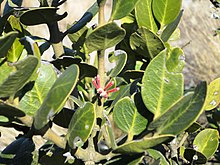
Petals are modified leaves that surround the reproductive parts of flowers. They are often brightly colored or unusually shaped to attract pollinators. Together, all of the petals of a flower are called the corolla. Petals are usually accompanied by another set of modified leaves called sepals, that collectively form the calyx and lie just beneath the corolla. The calyx and the corolla together make up the perianth. When the petals and sepals of a flower are difficult to distinguish, they are collectively called tepals. Examples of plants in which the term tepal is appropriate include genera such as Aloe and Tulipa. Conversely, genera such as Rosa and Phaseolus have well-distinguished sepals and petals. When the undifferentiated tepals resemble petals, they are referred to as "petaloid", as in petaloid monocots, orders of monocots with brightly colored tepals. Since they include Liliales, an alternative name is lilioid monocots.

Apocynaceae is a family of flowering plants that includes trees, shrubs, herbs, stem succulents, and vines, commonly known as the dogbane family, because some taxa were used as dog poison. Members of the family are native to the European, Asian, African, Australian, and American tropics or subtropics, with some temperate members. The former family Asclepiadaceae is considered a subfamily of Apocynaceae and contains 348 genera. A list of Apocynaceae genera may be found here.
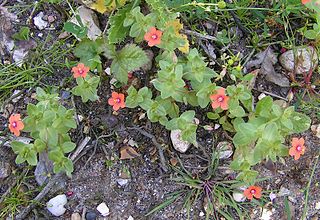
Anagallis is a genus of about 20–25 species of flowering plants in the family Primulaceae, commonly called pimpernel. The scarlet pimpernel referred to in literature is part of this genus. The botanical name is from the Greek ana and agállein, and it refers to the opening and closing of the flowers in response to environmental conditions.
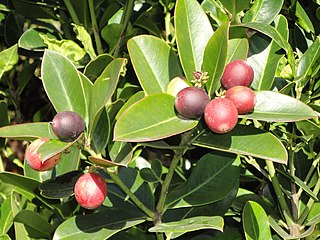
Acokanthera oppositifolia is a shrub used as the source of an arrow poison and to coat caltrops made from the sharp fruits of the puncture vine. All plants of the genus Acokanthera contain toxic cardiac glycosides strong enough to cause death. Acokanthera oppositifolia is widespread in southern and central Africa from Cape Province north to The Democratic Republic of the Congo + Tanzania.

Acokanthera is a genus of flowering plants in the family Apocynaceae. It comprises 5 species and is generally restricted to Africa, although Acokanthera schimperi also occurs in Yemen. Its sap contains the deadly cardiotoxic glycoside ouabain. The sap is among the most commonly used in arrow poisons, including those used for poaching elephant.

Acokanthera schimperi, belonging to the family Apocynaceae, is a small tree native to eastern and central Africa as well as to Yemen.
Eugenia rotundata is a species of plant in the family Myrtaceae. It is endemic to Sri Lanka.
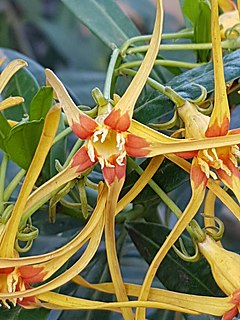
Strophanthus speciosus, commonly known as the forest poison rope, is a tree, shrub or woody climber which is native to southern Africa.
Strophanthus courmontii grows as a deciduous liana up to 22 metres (72 ft) long or as a shrub up to 4 metres (13 ft) tall, with a stem diameter up to 10 centimetres (3.9 in). Its fragrant flowers feature a white turning red and purple corolla tube, yellow with purple streaks inside. Habitats are forests and riverine thickets, from sea level to 1,400 metres (4,600 ft) altitude. S. courmontii is used in local medicinal treatments for rheumatism and as an aphrodisiac. The plant is native to Kenya, Tanzania, Malawi, Mozambique, Zambia and Zimbabwe.

Acokanthera oblongifolia is a plant in the family Apocynaceae. It grows as an evergreen shrub or small tree up to 6 metres (20 ft) tall. Its fragrant flowers feature a white tinged pink corolla. The berries are purple when ripe. Its habitat is dry forest and coastal thickets. Acokanthera oblongifolia is used in local African medicinal treatments for snakebites, itches and internal worms. The plant has been used as arrow poison. The species is native to Mozambique and South Africa.

Tabernaemontana elegans, the toad tree, is a shrub or small tree in the family Apocynaceae. It is native to eastern Africa.
Tabernaemontana stapfiana is a medium-sized tree in the family Apocynaceae. Its flowers feature white with yellow-throated corolla lobes. The fruit is fleshy grey-green, in pairs, each up to 20 centimetres (8 in) in diameter and weighing up to several kilograms. Its habitat is montane evergreen forests from 700–2,000 metres (2,300–6,600 ft) altitude. The plant is native to an area of Africa from Uganda south to Mozambique.

Carissa bispinosa grows as a shrub or small tree up to 5 metres (16 ft) tall. Its fragrant flowers feature a white corolla. The fruit is red when ripe. Its habitat is woodland and forest from 1,080 m (3,540 ft) to 1,630 m (5,350 ft) altitude. Vernacular names for the plant include "forest num-num" and "Y-thorned carissa". Carissa bispinosa is native an area from Uganda to South Africa.

Carissa tetramera, the sand num-num, is a plant in the dogbane family Apocynaceae. The specific epithet tetramera means "four parts", referring to the flower.
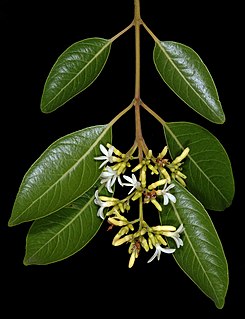
Diplorhynchus is a monotypic genus of plant in the family Apocynaceae native to tropical and southern Africa. As of August 2020, Plants of the World Online recognises the single species Diplorhynchus condylocarpon.

Pleiocarpa is a genus of plant in the family Apocynaceae first described as a genus in 1876. It is native to tropical Africa from Senegal to Tanzania and south to Zimbabwe. As of August 2013 the World Checklist of Selected Plant Families recognises 6 species:
- Pleiocarpa bicarpellataStapf - Cabinda, Cameroon, Republic of Congo, Gabon, Zaire, Kenya
- Pleiocarpa brevistylaOmino - Gabon
- Pleiocarpa muticaBenth. - Ghana, Ivory Coast, Liberia, Sierra Leone, Nigeria, Cameroon, Gabon, Central African Republic, Republic of Congo
- Pleiocarpa picralimoides(Pichon) Omino - Cabinda, Republic of Congo, Gabon
- Pleiocarpa pycnantha(K.Schum) Stapf - widespread across most of tropical Africa
- Pleiocarpa rostrataBenth. - Nigeria, Cameroon, Gabon
- Pleiocarpa camerunensis(K.Schum. ex Hallier f.) Stapf = Hunteria camerunensisK.Schum. ex Hallier f.
- Pleiocarpa hockiiDe Wild. - Acokanthera oppositifolia(Lam.) Codd
- Pleiocarpa simii(Stapf) Stapf ex Hutch. & Dalziel = Hunteria simii(Stapf) H.Huber
Pleiocarpa pycnantha is a plant in the family Apocynaceae.

Brachylaena rotundata S. Moore is an occasionally deciduous Southern African shrub or small tree growing to some 8m in height and of the family Asteraceae. It occurs in eastern Botswana, Transvaal, Mozambique, Zambia and Zimbabwe, growing in open woodland, on rocky koppies and slopes, and on stream banks. Kew accepts Brachylaena rotundata S. Moore as a species while 'Flora of Mozambique' treats it as a variety of Brachylaena discolor DC. It bears attractive foliage, green on the upper surface and silver-grey on the lower, leaves turning slightly reddish in autumn.
Leaves with petioles from 2 mm to 7 mm. long, lamina 4–15 x 2.5–6 cm., larger on coppice shoots, broadly oblanceolate or elliptic, obtuse to rounded at the apex, cuneate or rounded base, entire, occasionally coarsely dentate near the apex; upper surface araneous when young, or glabrescent; lower surface greyish tomentellous with prominent veins. Capitula sometimes preceding the leaves, young synflorescences with buds in axillary and terminal spikes, mature synflorescences with numerous capitula in dense terminal panicles 4–40 cm. long, or in short raceme-like panicles in axils of old leaves. Involucres cyathiform to obconic. Phyllaries minutely glandular outside, subobtuse, margins ciliolate, the outer phyllaries from c. 1 mm. long and ovate, the inner to c. 5 mm. long becoming lorate-lanceolate, narrowly obtuse or blunt at the apex; the outermost 5–8 series decreasing in size and extending down to the base of the capitulum stalk. Male flowers: corollas dull-yellow, 3–5 mm. long, lobes c. 1.5 mm. long and ± recurved; pappus uniseriate, setae 3–4 mm. long, subplumose, the seta barbs exceeding the seta axis in width. Female flowers: corollas dull-yellow, 3–5 mm. long, filiform, lobes erect up to c. 0.5 mm. long; achenes c. 4 mm. long, subcylindric-fusiform, narrowly c. 8-ribbed, pubescent; pappus 2-several-seriate, setae 4–5 mm. long, ± terete or flattened, seta barbs ± equalling the seta axis in width.""

Petalidium, commonly known as petal-bushes, is a genus of perennial shrubs in the acanthus family. They are native to sandy flats or stony slopes in the drier bush regions of Africa, India and the Mascarene Islands. The majority of species occur in frost-free, summer rainfall regions of southern Africa, and may be found from low to medium altitudes.
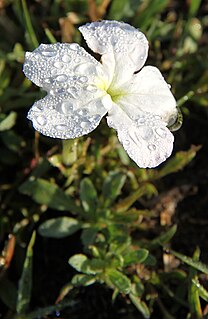
Cycnium tubulosum, the vlei ink-flower, is a slender hemiparasitic perennial plant of the broomrape family. Its range includes much of southern and eastern Africa, from South Africa to Ethiopia, including Madagascar. It has creeping, straggling or upright stems, with few narrow, entire leaves and erect, white or pinkish, slightly zygomorph flowers on a long tube, with five lobes, reminiscent of a Phlox-flower. It may not always be fully dependent on the supply of minerals by other plants, but usually makes connections with the roots of grasses. It can be found in moist, short grasslands, reaching altitudes of about 1,550 m (5,090 ft). Its conservation status in South-Africa is "least concern".
